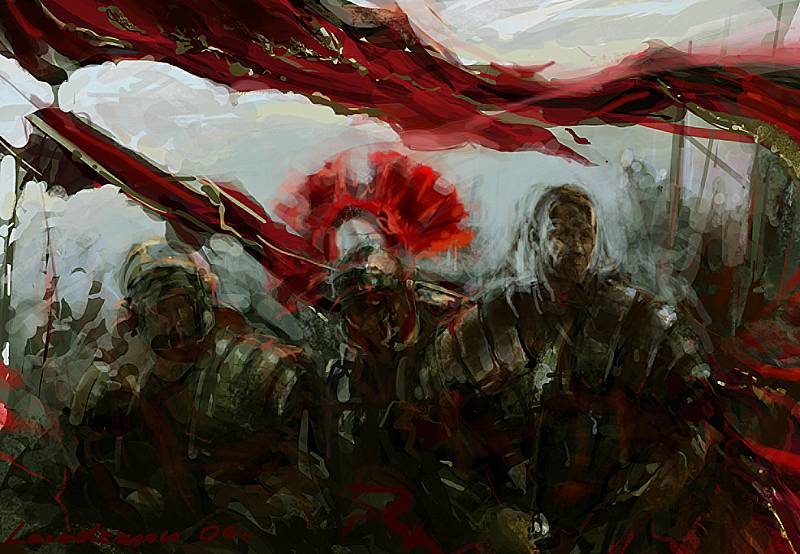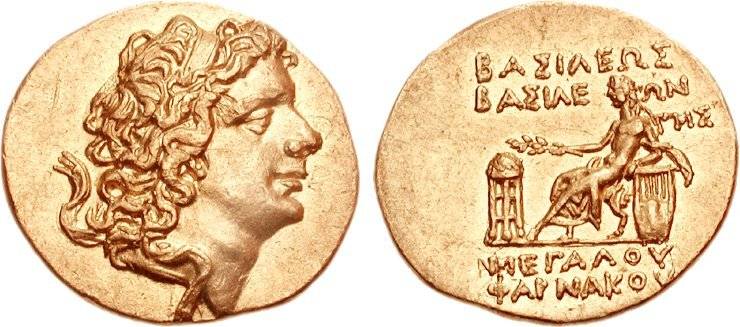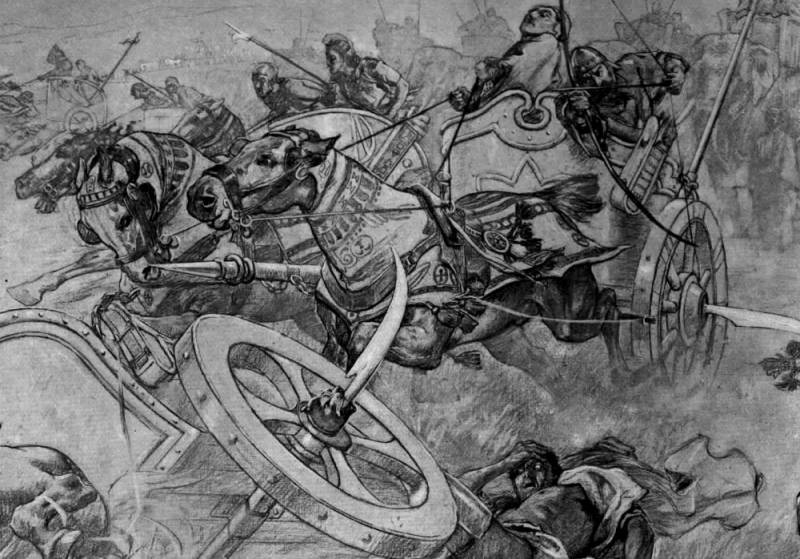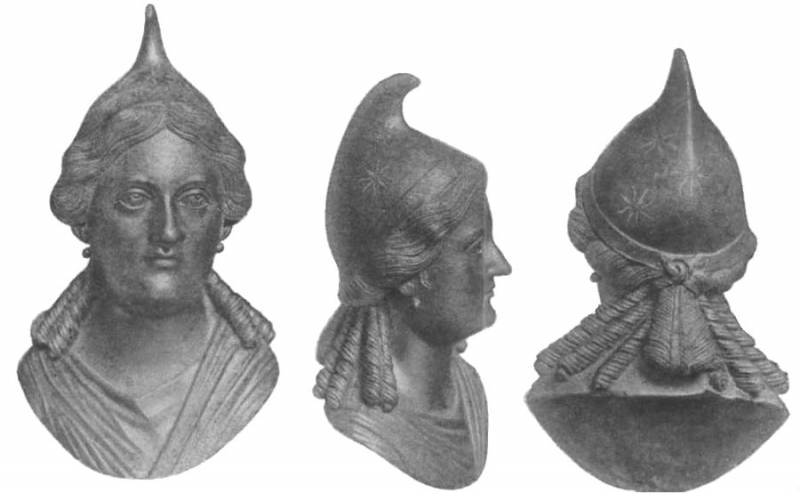Bosporan Kingdom. The heavy hand of Rome

Source: roman-glory.com
In the middle of the XNUMXst century BC. e. after the collapse of the Pontic state and the death of Mithridates VI Eupator, his son Pharnaces II was entrenched in power in the Bosporus. By betraying his father and raising a revolt against him, he hoped thereby to arouse favor with the Roman Republic and to keep at least part of the territories in his hands.
As a confirmation of his affection for the Romans, he embalmed his father's body and sent it to the commander Pompey. With a request to leave in his possession the former lands of Pontus or at least the Bosporus kingdom.
Friend and ally of the Roman people
The republic at that time had no time for the northern lands of the Black Sea.
And Pharnacs, having received the status, took over the reins of the Bosporus kingdom. However, given whose son the new king was and how he treated his father, Guineas Pompey limited his power in advance, granting autonomy to the largest city in the Asian part of the Bosporus - Phanagoria and the adjacent settlements.
Pharnaces had no choice but to agree to the proposed terms.
He was well aware that his position (as a king) was very precarious at that moment. And the throne could slip out of hand at any moment. Moreover, given the fact that there were no Roman troops in the region.
In other matters of politics, little limited the power of the ruler.
During his early years on the throne, Pharnaces were mainly concerned with restoring trust among the Greek cities and suppressing the separatist sentiments of the barbarian tribes. In his policy, the young tsar openly condemned the actions of his father in the last years of his life and condemned the general taxes and harsh duties with which Mithridates VI Eupator imposed the inhabitants of the Greek city-states.
Along the way, flirting with Rome and literally imposing his loyalty to him, Pharnaces gradually strengthened his power in the region, hatching more serious plans than ruling the Bosporan kingdom.
Betrayed once, betrayed the second
Increased tensions in Rome, the threat of civil war, and the beginning of the struggle between the triumvirs Caesar and Pompey in the 50s. e. prompted Pharnaces to start decisive military actions aimed at restoring the territories of the Pontic kingdom.
Having subjugated Phanagoria, the king left a certain Asander as governor. And in 49/48 BC. e. went on a military campaign.
Having conquered Colchis, Lesser Armenia and Cappadocia with relative ease, Pharnacs abruptly changed the vector of friendship.
Refusing the call for help from Pompey, he expelled all his supporters from the conquered lands. In his new political game, the Bosporus king tried to win Caesar's favor and enlist his support in the further unification of the lands of the Pontine kingdom.
However, the great commander had his own views on the situation.
Busy with the restoration of power in Egypt, Caesar instructed the Roman commander Dominius Calvin to secure the return of the lands taken from them to the friends of the Romans.
Under the command of Calvin, the XXXVI legion, two legions created by the Galatian king Deiotar according to the Roman model, two hundred horsemen, a legion of recruits from Pontus and auxiliary troops from Cilicia came forward.
The number of Pharnaces' troops in the battle with Dominicus Calvin is unknown. However, of course, the initiative for the battle was in his hands.
At first, the king tried to use military cunning. Located in a gorge beyond the pass from the positions of the Romans, he collected a large number of livestock from the local population and released them for free range. Pharnace's plan was simple. Having set aside an ambush, he hoped that the Roman troops would try to capture the herds, scatter over the territory and it would be easy to kill them, delivering unexpected blows from several directions.
In parallel with these preparations, Pharnaces did not stop sending ambassadors to the Roman camp with an offer of peace and friendship.
In his subsequent actions, the Bosporus king will constantly resort to this maneuver. Having seized territories, he will each time send ambassadors to the enemy's troops with a proposal for peace, thereby acting as a victim in the person of the local residents, who, despite the desire to end the war, is forced to defend against Roman aggression.

Image of Pharnaces on a gold coin. Source: wikipedia.org
Despite the tricks of Pharnaces, the ambush failed.
And the soldiers who were there had to be recalled. Only then did Dominius Calvin come closer to Nicopolis, where the Bosporus king settled. And set up camp right in front of the city.
In response, Pharnaces led his troops into battle formation, offering battle. The Roman commander was in no hurry to accept the battle, lining up part of the army in front of the defensive rampart. While the rest of the warriors were completing the fortification of the camp.
The stand could drag on. However, Pharnace was lucky.
At night, his troops managed to intercept the letter, from which it became clear that Caesar demanded that Calvin immediately send him military aid to Alexandria, where he found himself in a difficult situation. As the Roman general was forced to leave soon, Pharnaces chose a different tactic.
The tsar ordered to dig two ditches at a short distance from each other, more than a meter deep. Between them, he lined up his infantry, and placed numerous cavalry on the flanks outside the ditches.
The Roman army could no longer be under the protection of the camp. And I was forced to fight. The most reliable XXXVI legion took up a position on the right flank. Recruited from the inhabitants of Pontus - on the left. The other two occupied the center of the formation. Auxiliary cohorts formed a reserve.
After the signal for battle from both sides, a fierce battle unfolded, proceeding with varying degrees of success. The XXXVI legion struck at the royal cavalry, pushed it back, forced the ditch and struck the enemy's rear. The Pontic Legion on the left flank was not doing so well. Pushed aside from his positions, he made an attempt to strike and cross the moat. But he was fired upon by the enemy. And almost completely died.
The central groups of forces with difficulty held back the onslaught of the army of Pharnaces. And they suffered huge losses. In the end, most of the Roman army was dispersed. And only the XXXVI Legion managed to retreat in an organized way.
Inspired by the victory, Pharnaces captured Pontus and Bithynia. Having replenished the army and procured the old sickle-bearing chariots found in the royal arsenal, he continued his campaign of conquest.
However, the further situation for the king began to develop not so smoothly.
Bad luck streak
Many Pontic cities, seeing the cruel measures against the occupied territories, did not open the gates for the son of Mithridates VI Eupator. In his own Bosporan kingdom, a rebellion broke out, led by him as governor Asander.
On top of that, Caesar, having successfully completed the Alexandrian War, arrived in Asia Minor to restore Roman order.
In fact, Pharnaces was trapped.
Not finding mass support among the local population, unable to retreat to the lands of the Northern Black Sea region, he was forced to enter into negotiations with Caesar, going for an outright bluff.
Through his ambassadors, Pharnaces offered peace to the Roman general. Declaring at the same time that his army is invincible and did not lose any of the twenty-two battles in which he took part.
The former Bosporus tsar did not forget about his previous political line. So, he even offered Caesar to intermarry with him, passing off his daughter Dynamia as a Roman commander.
Caesar's response to suggestions and indirect threats was simple. He demanded to leave the conquered territories and retreat together with the entire army. For reasons that there was nowhere to return, Pharnacs decided to give a general battle.
The troops converged at the small town of Zela, where Mithridates once defeated the Roman general Triarius. The tsar's hope that luck would smile at him here was not justified.
Acting as decisively as possible, Caesar occupied a hill not far from the enemy's army and began hastily to build camp fortifications.
Deciding not to hesitate and catch the Romans by surprise, August 2, 47 BC. e. Pharnaces moved his troops to attack.
The Romans, considering these actions as tactical maneuvers, did not take them for the beginning of the battle. But, quite unexpectedly, the dense masses of soldiers rushed up the slope to attack. Caught by surprise, Caesar hastily issued the command to form the legions.
But when the formations of the Roman army had not yet been completed, sickle-bearing chariots fell upon them, each of which was led by a team of four horses.
Designed for surprise and psychological effects, it should have caused confusion in the Roman army and given time for the main group of troops to reach the top of the hill.
At first, Pharnace's idea came true.
The Roman legions were confused. And they did not have time to rebuild by the time the infantry approached. Despite the inconvenience of the terrain for the advancing side, a fierce battle ensued, which lasted four hours and ended in a crushing victory for the Romans.
It was after the battle at Zele that Caesar pronounced his famous:
Fleeing to Sinop, Pharnaces managed to get to the Bosporus by ships. And, relying on the support of the Scythian and Sarmatian tribes, he was even able to capture Theodosia and Panticapaeum.
However, then luck finally left him.
The former king died in one of the battles, opening the way to the throne for his former governor Asander.
The iron will of the Roman Empire
Despite the fact that the rebellious king died, Rome did not like at all that in the kingdom under his control, their own games were being played in the struggle for the throne.
To establish power in the Bosporus, Caesar instructed his friend Mithridates of Pergamon to move against Asander and take the throne of the kingdom himself. The claims of the Roman henchman were unsuccessful. And in 46 BC. e. he died. Having left for the capital, Caesar could not intervene in these events. And the power actually remained with Asander.
Having failed to achieve recognition from Rome, the former governor married the previously mentioned daughter of Pharnaces, Dynamia. Thus, legitimizing their stay on the throne.
Becoming the successor of the Mithridates dynasty, Asander actively began to increase the defenses of the borders of the Bosporus kingdom, having established himself as a strong and purposeful ruler.
Since that time, a significant influx of new nomadic tribes has been observed on the territory of the Northern Black Sea region, which actively penetrated the Bosporus environment, increasing the military potential of the kingdom. Among the peoples who came, it is worth highlighting the barbarians - the Aspurgians, who will still appear in the historical arena of the Bosporus.
Asander ruled the kingdom as king for about twenty-four years (45/44 to 21/20 BC).
Then he divided the power over the Bosporus between himself and Dynamia. Most likely, this decision was made by him because of his venerable age and inability to quickly respond to emerging challenges.
It is important to mention that even during the life of Asander by 17/16 BC. e. on the territory of the Bosporus kingdom, a certain Scribonius appeared, who pretended to be the grandson of Mithridates VI Eupator. Referring to the order of Augustus, he took Dynamia as his wife and declared himself king of the Bosporus.
Upon learning of this, the Roman general Agrippa sent the Pontic king Polemon I to the Northern Black Sea region with the aim of overthrowing the impostor and establishing Roman power in the kingdom.
The Bosporians, most likely not wanting a new conflict with Rome, themselves eliminated Scribonia.
However, Polemon I could not independently settle on the throne due to the resistance of a part of the local population. And only the direct intervention of Agrippa forced the Bosporians to recognize the protégé of Rome.
To establish power, Polemon I, like his predecessors, married Dynamia, legally securing the throne. Their marriage did not last long. Already in 12 BC. e. he married Pythodoris, the granddaughter of Mark Antony. And he had three children by her.
Despite the support of Rome, the position of the new king was fragile.
This was especially evident in the Asian part of the Bosporus kingdom, in order to strengthen the power in which Polemon I already in 14 BC. e. launched a series of military campaigns aimed at suppressing the unrest. The course of these events is evidenced by traces of destruction found in the areas of Phanagoria, Bati (Novorossiysk), and also Gorgippia (Anapa).
The Aspurgians (already mentioned earlier) were especially active in the fight against Polemon I.
There are no reliable sources about the culture to which this barbarian group belonged. Coming to the service of Asander, they quickly gained a foothold in the territory, forming an impressive military force. According to a number of historians, the Aspurgians belonged to the Sarmatian nomadic environment, who arrived to the northern shores of the Black Sea from the Caspian steppes.
Given the territory that was provided to them for accommodation (namely, between Phanagoria and Gorgippia), historians suggest that this was not a full-fledged nomadic group, but rather a military squad consisting of professional warriors led by one leader. It is even possible that in order to strengthen the alliance, the ties between the Bosporus rulers of the time of Asander and the Aspurgian tribes were reinforced by kinship relations that were actively practiced in the region.
It is extremely important to note the version that the Queen Dinamia at the very end of the XNUMXst century. BC e. adopted the son of one of the Aspurgian leaders, thus bringing the barbarian elite closer to the ruling dynasty.
Returning to the wars of Polemon I, it is worth noting that his struggle for the Taman Peninsula ended in failure.
In 8 BC. e., according to the testimony of the historian Strabo, the king of the Pontic and Bosporus kingdoms died at the hands of the Aspurgians.
Nevertheless, despite the death of the governor of Rome and the active resistance of the barbarian elite of the imperial domination, from the end of the XNUMXst century BC. e. The Bosporan kingdom firmly entered the sphere of Roman influence.
On their borders, the rulers of the Northern Black Sea region had to maintain friendly relations with neighboring barbarian tribes, track the movements of nomadic tribes, protect the population from raids and, if possible, not unleash wars aimed at seizing territories.
The Bosporan kingdom passed into a new era for itself, in which the Roman Empire now played a significant place.
Sources:
1. Appian. "Book XII of the Mithridatic Wars" Translation by S.P. Kondratieva
2. Strabo. "Geography. Book XI "Translation by G.А. Stratanovsky, Ladomir Publishing House, 1994
3. Strabo. "Geography. Book XIII "Translation by G.А. Stratanovsky, Ladomir Publishing House, 1994
4. Yu.A. Vinogradov, V.A. Goroncharovsky "Military history of the Bosporus kingdom" Publishing house "Lomonosov", 2017
5. V.M. Zubar, A.S. Ruslyaev "On the shores of the Cimmerian Bosporus" Publishing house "Stilos", 2004
6. "On the Alexandrian War." Translated by M.M. Pokrovsky, Ladomir Publishing House, 1993
7. Cassius Dion “Roman History. Book XXXVII ". Loeb Classical Library, translated by V.V. Ryazanova.


Information